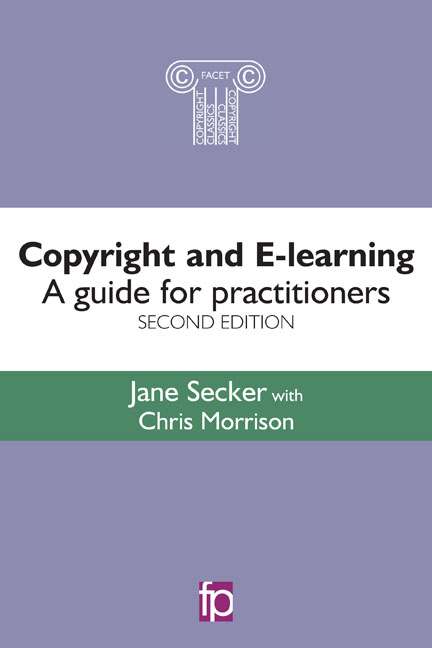Book contents
- Frontmatter
- Contents
- Figures, tables and case studies
- Preface to the second edition
- Introduction
- Abbreviations and acronyms
- Glossary
- 1 E-learning and copyright: background
- 2 Digitizing text-based content for delivery in a VLE
- 3 Using digital media: video, images, sound and software
- 4 Copyright issues and born digital resources
- 5 Copyright in the connected digital environment
- 6 Copyright education and training
- 7 Conclusion
- Further resources
- Index
2 - Digitizing text-based content for delivery in a VLE
Published online by Cambridge University Press: 08 June 2018
- Frontmatter
- Contents
- Figures, tables and case studies
- Preface to the second edition
- Introduction
- Abbreviations and acronyms
- Glossary
- 1 E-learning and copyright: background
- 2 Digitizing text-based content for delivery in a VLE
- 3 Using digital media: video, images, sound and software
- 4 Copyright issues and born digital resources
- 5 Copyright in the connected digital environment
- 6 Copyright education and training
- 7 Conclusion
- Further resources
- Index
Summary
Introduction
This chapter is concerned with the copyright issues associated with digitizing or scanning text-based works held in paper form for use in online learning. This includes both published material such as books and academic journals (what the CDPA defines as literary works), the images and illustrations that they contain, and potentially unpublished content such as personal correspondence and manuscripts. This chapter only considers images embedded in literary works, and standalone images are discussed in Chapter 3. Digitizing traditional paper resources for online delivery allows distance learners to access the content easily, from the convenience of their chosen digital device. There has also been a growing demand from campus-based students to have access to core readings in electronic format. Library statistics from groups such as SCONUL (Society of College, National and University Libraries) demonstrate that while campus-based students visit academic libraries just as frequently as they traditionally have, they are increasingly accessing readings in digital format (SCONUL, 2015). Library visits are often driven by the growing use of the space for learning and group work. However, significant numbers of students in the UK study part-time, with over 600,000 students in 2013– 14 registered as part-time according to the Higher Education Statistics Agency (HESA, 2015) and far more working while they study and requiring flexible access to learning resources. The trend for electronic access is also related to the different expectations of young people about how they access information, as discussed in Chapter 1. Libraries are responding to increased demands for digital readings and find it relatively easy to produce digital readings in-house, with scanners and multifunctional devices now being inexpensive to purchase. Some libraries are also motivated by a desire to reduce the physical size of the library collection. While many institutions have addressed this by adopting ‘e-first’ policies (if an electronic version is available they will purchase this rather than the print version) when purchasing new content, there is still a place in many libraries for digitization. This is largely an interim reaction to the fact that many publishers have still not digitized their back catalogues.
In the UK, the provision of core readings in scanned format has escalated in the past ten years, largely facilitated by the inclusion of scanning rights in the CLA blanket licences.
- Type
- Chapter
- Information
- Copyright and E-learninga guide for practitioners, pp. 47 - 86Publisher: FacetPrint publication year: 2016



